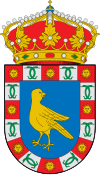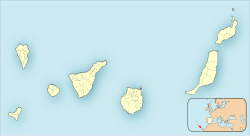Morro Jable
| Pájara | ||
|---|---|---|
| Municipality | ||
|
||
 Location in Fuerteventura |
||
| Location in Canary Islands | ||
| Coordinates: 28°21′4″N 14°6′27″W / 28.35111°N 14.10750°WCoordinates: 28°21′4″N 14°6′27″W / 28.35111°N 14.10750°W | ||
| Country | Spain | |
| Autonomous Community | Canary Islands | |
| Province | Las Palmas | |
| Island | Fuerteventura | |
| Government | ||
| • Mayor | Rafael Perdomo Betancor (PSC-PSOE) | |
| Area | ||
| • Total | 383.52 km2 (148.08 sq mi) | |
| Elevation(AMSL) | 196 m (643 ft) | |
| Population (2013) | ||
| • Total | 20,931 | |
| • Density | 55/km2 (140/sq mi) | |
| Time zone | CET (UTC+0) | |
| • Summer (DST) | CEST (GMT +1) (UTC+1) | |
| Postal code | 35628 | |
| Area code(s) | +34 (Spain) + 928 (Las Palmas) | |
| Website | www.pajara.es | |
Pájara is a town and a municipality in the southwestern portion of the island of Fuerteventura in the Province of Las Palmas in the Canary Islands. Its population is 20,931 (2013), and the area is 383.52 km². Pájara is both the southernmost and the westernmost municipality on the island. Pájara is also the largest municipality on the island. The largest towns in the municipality of Pájara are Morro Jable and Costa Calma, both situated on the coast. The small port Ajuy is situated in the north of the municipality, near Betancuria. The Jandía peninsula is part of the municipality.
The church of Nuestra Señora de Regla in Pájara town has interesting sculptures of sun pattern, snakes, panther and birds above the main entrance. It is thought by some specialists to show Aztec influence.
Beach at Ajuy
Beach at El Cofete
Nuestra Señora de Regla church, Pájara
Caleta Negra beach
...
Wikipedia


